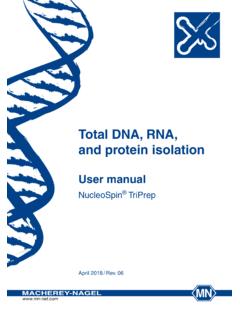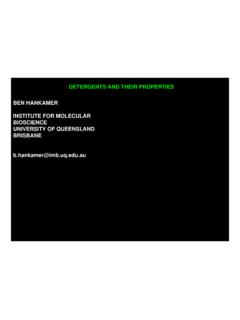Transcription of Potein as - Genotech LTD
1 Handbook &Selection GuideProtein AssayscG-Biosciences 1-800-628-7730 Assay IntroductionProtein assays are one of the most widely used methods in life science research. Estimation of protein concentration is necessary in protein purification , electrophoresis, cell biology, molecular biology and other research applications. Although there are a wide variety of protein assays available, none of the assays can be used without first considering their suitability for the application. Each assay has its own advantages and limitations and often it is necessary to obtain more than one type of protein assay for research applications.
2 This guide is designed to help researchers select the most appropriate assay for their offers assays that are enhancements of dye binding protein assays (Bradford), protein assays based on copper ions (Lowry), or a novel test strip and spot application assay. Dye Binding Assays (Bradford)The dye binding protein assay is based on the binding of protein molecules to Coomassie dye under acidic conditions. The binding of protein to the dye results in spectral shift, the color shifts from brown (Amax= 465nm) to blue (Amax= 610nm). The change in color density is read at 595nm and is proportional to protein concentration.
3 The basic amino acids, arginine, lysine and histidine play a role in the formation of dye- protein complexes color. Small proteins less than 3kDa and amino acids generally do not produce color changes. CB and CB-X protein assays are dye binding protein and SPN -htp protein assays are spin column format dye binding Ion Based Assays (Lowry & BCA)In the copper ion based protein assays, the protein solution is mixed with an alkaline solution of copper salt. Under alkaline conditions, cupric ions (Cu2+) chelate with the peptide bonds resulting in reduction of cupric (Cu2+) to cuprous ions (Cu+).
4 If the alkaline copper is in excess over the amount of peptide bonds, some of the cupric ions (Cu2+) will remain unbound to the peptide bonds and are available for detection (Figure 1). protein assays based on copper ions can be divided into two groups, assays that detect reduced cuprous ions (Cu+) and assays that detect the unbound cupric (Cu2+) ions. The cuprous ions are detected either with bicinchoninic acid (BCA) or Folin Reagent (phosphomolybdic/ phosphotungstic acid) as in the protein assays based on Lowry method. Cuprous ions (Cu+) reduction of Folin Reagent produces a blue color that can be read at 650-750nm.
5 The amount of color produced is proportional to the amount of peptide bonds, size as well as the amount of protein /peptide. The presence of tyrosine, tryptophan, cysteine, histidine and asparginine in protein contributes to additional reducing potential and enhances the amount of color produced. Hence, the amount of blue color produced is dependent on the composition of protein molecules. The reaction of cuprous ions (Cu+) with the bicinchoninic acid and color production is similar to that of Folin the assays based on the detection of unbound cupric ions, the protein solution is mixed with an amount of alkaline copper that is in excess over the amount of peptide bond.
6 The unchelated cupric ions are detected with a color-producing reagent that reacts with cupric ions. The amount of color produced is inversely proportional to the amount of peptide bond. Non-Interfering (NI ) protein Assay is based on the detection of unbound cupric ions (Cu2+) under alkaline Strip Based protein AssayThis is in effect a chromatographic capture method where the flat surface of the test strip acts as the solid matrix or support. protein solution is applied on a specific protein binding test strip by point of contact capillary action. Under a specific buffer condition, as the protein enters into the matrix of the test strip, it binds instantly and saturates as protein solution diffuses into the test strip in a circular manner.
7 A circular protein imprint is produced which is developed into visible protein spots with a protein specific dye. The diameter of the protein spot is proportional to protein concentration (Figure 2). By measuring the diameter of the protein spots with a predeveloped measuring gauge, the amount of protein can be is based on the use of test trips and spot application for protein 2: The linear relationship of protein BSA concentration with the protein spot diameters. Figure 1: The interaction of copper ions with ASSAY SELECTIONThe nature of the protein sample is by far the most important consideration for protein assay selection.
8 If the protein sample is in a dry and solid form, it can be easily solubilized in a protein assay compatible buffer. Unfortunately, the majority of protein samples are processed and complex solutions, containing many non- protein , interfering agents. Apart from the nature of the protein sample there are other considerations that will affect the quality of protein estimation. The following section deals with many of the issues that effect the accuracy and sensitivity of protein AgentsProteins are complex polymers of amino acids with numerous modifications and structural variations and hence require endless varieties of chemical agents for stability and analysis.
9 The presence of non- protein agents in protein solutions creates challenges for protein assays. protein solutions containing reducing agents, metal chelating agents, dyes, amines, and sugars, cannot be estimated with the protein assays based on copper ions. On the other hand, protein solutions containing surfactants (detergents) interfere with the dye based protein assays (Figure 3). The best protein estimation is possible with assays that either substantially removes non- protein agents from the protein solutions or the methods that circumvent the interfering affects of non- protein agents present in the protein (NI ) protein Assays, CB-X , SPN and SPN -htp are designed to first remove non- protein agents from the protein solutions.
10 The dotMETRIC protein assay on the other hand is designed to circumvent the interfering effects of non- protein agents in the protein Preparation For protein analysis, samples must be in a solubilized form. Solid samples must be first solubilized in an appropriate buffer, preferably containing non-interfering agents. When working with cells and tissues, the first step is to disaggregate the sample using a grinding tool and then solubilize it in a lysis buffer. The soluble protein is collected either by centrifugation or filtration. The lysis buffer should preferably be free from agents that may interfere with protein assays.








